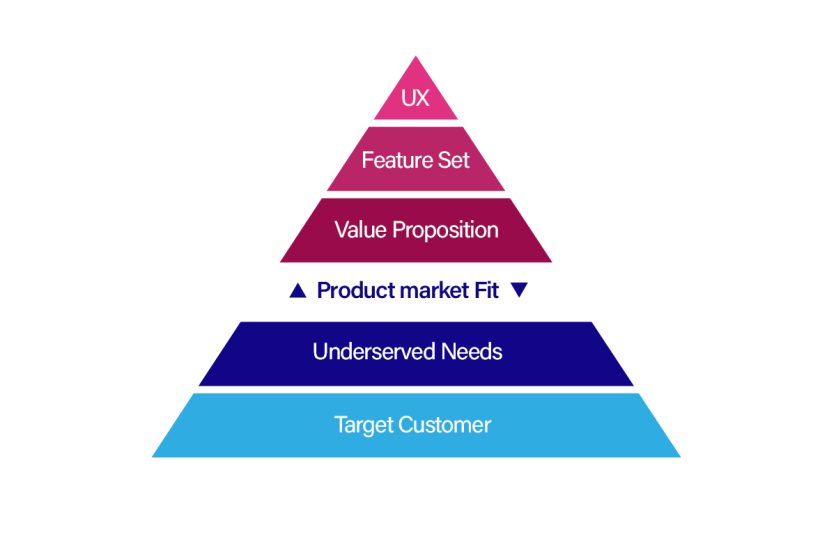Product-market fit is crucial for the success of startups. But how can startup market research methods help you understand your target audience and shape your product for success? In this blog, we’ll explore the concept and how to reach it.
What is Product-Market Fit in Startups?
Let’s start with a fact: according to statistics, 34% of startups fail due to a lack of product-market fit. Many startups rush into the market without properly assessing whether anyone actually needs their product or service. Product-market fit is fundamental to the success of new businesses. But how can we ensure that our product aligns with the market? The Jahesh Innovation Center explores this concept and strategies to achieve product-market fit in this blog.
Who is Responsible for Product-Market Fit in Startups?
Generally, product-market fit is associated with marketing and product management. In reality, achieving it is a shared responsibility across the company. Sales, startup market business development research, support, finance, and other departments all contribute to reaching this critical milestone.

startup market research tip
Steps to Analyze Market for Product-Market Fit in Startups
The Impact of Product-Market Fit on Startup Success
- Market Research: The first step is to conduct startup market research using reliable startup market research tools. This includes identifying potential startup customer research needs, problems, and desires, as well as assessing market size and trends.
- Market Segmentation: Divide your target market into segments and focus on those with the greatest need for your product or service. This allows more efficient allocation of resources.
- Competitor Analysis: Examine what competitors offer and how they meet customer needs. Understanding competitors’ strengths and weaknesses in startup market research analysis helps you improve your product and create competitive advantages.
- Customer Needs Assessment: Selling a product to an oversaturated market is not ideal. Instead, ask what customers are dissatisfied with and how your product can solve their problems. Use startup market research survey questions, interviews, and pilot tests to provide direct feedback from potential customers, helping you optimize your product for real needs.
- Define Product Value Proposition: Understand how your product can perform better than competitors’ offerings. Consider quality, price, additional services, and marketing efforts.
- Product Evaluation and Improvement: Based on feedback, refine your product. You may need to add new features or adjust existing ones to better align with market needs.
- Market Testing (MVP Launch): Introduce a limited version of your product to the target market and gather additional feedback. This helps identify final issues and ensures the product fully meets market demands. You can also use a startup market research report template to track insights efficiently.
Product-market fit significantly affects startup success by:
- Increasing customer satisfaction: Meeting customer needs precisely improves satisfaction and encourages loyalty and referrals.
- Boosting sales and revenue: Products that fit the market sell better and increase startup revenue.
- Reducing marketing costs: A suitable product reduces the need for expensive customer acquisition campaigns.
- Enhancing competitiveness: Product-market fit creates competitive advantages and increases market share.
Sean Ellis’ Method
Sean Ellis, author of Growth Hackers, started at a software company called Xobni by creating a customer satisfaction survey to assess loyalty, primarily targeting managers.
He deliberately avoided the word “satisfaction” because, as he told Built In, “A good manager is never satisfied.” Instead, he asked: “How would you feel if you could no longer use [this product]?” Respondents could choose: very disappointed, somewhat disappointed, not disappointed (product isn’t that useful), or would stop using it. This formed the basis for a quantitative framework to measure product-market fit.
Ellis highlighted that surveys are fast to deploy and provide deep insights about users, their past experiences, and why they tried the product. Startup market research case study examples can further guide implementation. Surveys should ideally target 40 users who have interacted with the product at least twice in two weeks.
Net Promoter Score (NPS)
NPS measures the likelihood that users recommend your product to others. It is calculated with one question: “How likely are you to recommend our product or service to a friend or colleague?”
NPS = % of promoters – % of detractors
Score 6 or below → Detractors
Score 7–8 → Passive
Score 9–10 → Promoters
NPS can indicate product-market fit and reflect customer experience and perceived company credibility.
Going to Market
Some skeptics, like Alex Villen, a decade-long product manager at early-stage startups, see these methods as lagging indicators. The best way to know if people want your product is if they actually pay for it.
If launching without proven product-market fit is costly, find a cheaper way to gauge purchase intent. For a consumer app, this could involve running ads to see if people click.
There’s a trade-off between early investment and the quality of signals. Fully building and launching a product provides a strong test at high cost, while quick surveys offer cheap insights but weaker signals. Finding the right balance is key.
Common Mistakes to Avoid
- Overly optimistic projections without data
- No exit or pivot strategy
- Ignoring real data in decision-making
- Overloading information—be concise
- Undefined distribution channels
- Underestimating competitors
- Ignoring real customer needs
Why Product-Market Fit Matters
Achieving product-market fit helps startups reach ROI faster and grow quicker. Without it, resources may be wasted on products the market doesn’t need.
With proper startup market research methodology and deep understanding, you can create products people truly want and achieve the success you’ve envisioned.
Conclusion
Understanding product-market fit helps you identify target customers and develop the right product or service for them. Ignoring this concept can lead to confusion and misaligned offerings. Maintaining continuous customer interaction provides critical insights into product-market fit, while proper implementation ensures customers receive suitable products or improved services.
Ready to Turn Your Idea into a Scalable Business
Partner with Jump Lab to transform your startup market vision into a thriving enterprise. Our hands-on approach combines strategic thinking, sustainable execution, and creative visual startup market design to bring your ideas to life. Contact us today to start building your future.
See Jump Lab packages and get information on how strategy can grow marketing and the startup market.



